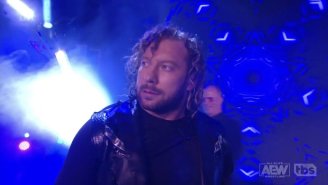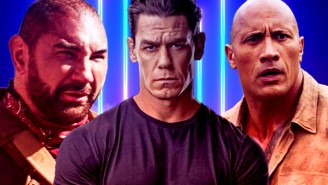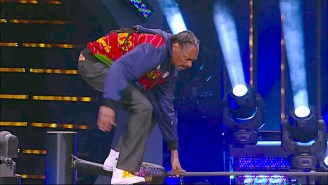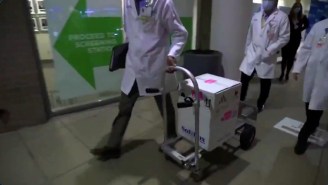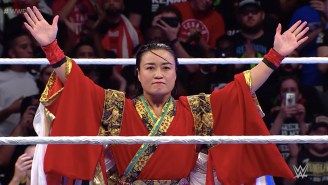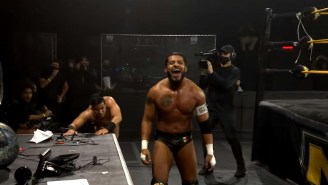I was born at the exact right time for ECW. No matter how it’s content is regarded today, in 1997 you could not have made a more appealing product to a teenage boy than ECW. I was crazy for it and went to great lengths to see it.
I first saw ECW in 1995 when I bought a bootleg Best Of tape at a comic book convention. The tape had been copied so many times that you could barely make out who was wrestling through the blurry lines on the television. In order to watch ECW’s weekly TV show I had to become a tape trader.
Once a month, for the next few years, I would mail two blank VHS tapes and a postage paid return envelope to a guy across the country who I met on the internet. He would mail me back one of the VHS tapes with a month’s worth of ECW TV on it and keep the other VHS tape as payment. That was a lot to go through for a teenage kid who didn’t have a car. So you can imagine how I felt when I heard ECW was going to air a show live on pay-per-view.
That was twenty years ago and literally everything has changed since then, including my taste in wrestling. I was so excited for Barely Legal in the spring of 1997, but in 2017 I could barely remember it. So I sat down to watch it on its 20th birthday.
If you like your shows loaded with cheap knockoff music, then you can watch Barely Legal right here on the WWE network. But if you want the real ECW experience, you should watch a third generation VHS dub that you got in a tape trade from a very shady dude in Pittsburgh.
Worst: I Still Couldn’t Watch It Live
Unfortunately, I couldn’t watch the show live on that historic night in 1997. Despite repeated calls and letters to my cable provider, they refused to carry the show. That’s right, every day for weeks leading up to the show, I called my local cable company and hand-wrote them letters (I didn’t have email yet) asking that they please carry Barely Legal. Why? Because Paul Heyman told me to, and in 1997 if Paul Heyman told me to get cut open by New Jack I would have done it. So what’s 20 or 30 phone calls to the good folks at Cox Communication?
It wasn’t just my local cable company, either. Across the nation, cable companies refused to air the show due to perceived content of extreme violence and sex (even though those same cable companies aired hours of pay-per-view porn nightly in 1997). So Paul reached out through the television to his kool-aid drinkers like me to hassle the cable companies into carrying it — the ’90s version of angrily tweeting at a company.
It didn’t do much good. I was left reading the results in a chat group at 3 a.m. that night. But don’t despair; I watched all the other ECW pay-per-views live as they aired.
Barely Legal ended up being a financial success. Depending on who you believe, it got anywhere between 45,000-104,000 buys. Compare that to the 176,000 buys the WWE got the same month with their In Your House pay-per-view … that’s not too shabby for a start-up. Now that ECW was profitable to the cable companies, it’s content didn’t seem to be that big of an issue anymore. Later ECW pay-per-views became more widely available.
Worst: The Dudley Kidz
The first image of the show is an iconic one. It’s a shot from the hard camera showing the jam-packed ECW arena and the crowd going crazy chanting E-C-Dub. Fans are spilling into the frame on all four sides of the ring, practically covering our view of it. The bottom of the screen looks like Mystery Science Theater 3000 if the robots were constantly flipping middle fingers. The first match is not so iconic. It’s an underwhelming Tag Team Title match featuring The Dudley Boyz.
The Dudleys are one year into their ECW run and it’s all starting to come together for them. They had just won their first tag championship less than a month before the pay-per- view. By this time next year they would be three-time champs and bonafide stars.
Their opponents are Perry Saturn and a partner of his who is less memorable than Moppy, John Kronus. They were called The Eliminators, and were known for their super-over finisher Total Elimination, a move that still looked pretty cool even though it required their opponent to stand up straight in the middle of the ring and look into the hard camera for an ungodly long time.
The weirdest thing about watching this match today is seeing how dominated the Dudleys get. It’s a bit shocking considering what they would go on to accomplish. They don’t get in much offense except for at the beginning of the match, and after that it’s pretty much an Eliminators spot fest with Saturn jumping all over the place. There are a few sloppy spots in it that made me real glad I’m watching it twenty years later and know Saturn is okay. Relatively okay.
Best: Extreme Haircuts
Rob Van Damm Vs. Lance Storm is the second match on the card and OH MY GOD WHAT IS THAT ON LANCE STORM’S HEAD?! It’s too bushy to be a rat-tail, but it’s not a ponytail. Is it some kind of Canadian mullet? It looks like he cut the ponytail off of a five-year-old blond girl and glued it to the back of his head. The only thing scarier than the haircut is that I didn’t notice it until now.
Oh wait, there is another thing that’s scarier: the amount of chair shots to the head I just watched. This is one of those matches that at the time I thought was pretty tame but now seems brutal. So many of the chair shots seem unnecessary and that makes them even worse.
Best: BWO In Any Language
At the time, one of the most interesting things about Barely Legal was a six-man tag match featuring participants from Michinoku Pro. a Japanese-based promotion that wrestled a Japanese lucha libre style. At least that’s what they called it at the time. Today the style just looks like most major American indie promotions. I’ve seen this match at every PWG event.
Michinoku Pro had a lot of buzz around it at the time, but it was even harder to get your eyes on than ECW. It was mind-blowing that we would have the opportunity to see them wrestle. I remember paying special attention to this match when I first saw the show because I couldn’t imagine when I would get to see guys like Taka Michinoku and The Great Sasuke wrestle again, if ever. Turns out it would be a few weeks later in WWF. But for a short period of time, this was very special.
Best: Everything But The Match
Shane Douglas vs. PitBull #2 for the ECW World Television Championship was a pretty typical ECW match, but it was made to feel special by a great storyline leading up to Barely Legal. Shane Douglas had broken the neck of Pitbull #1 so his partner, the aptly named Pitbull #2, was out for revenge. This match is a great example of one of the keys to ECW’s success. Paul Heyman’s writing was so good that it would often make up for lackluster matches.
I can remember every beat of the Shane Douglas/Francine/Pitbull storyline, but prior to rewatching Barely Legal I couldn’t remember a thing about any of the matches that took place between them. In fact, I don’t recall much about any Pitbulls match ever, but the image of Pitbull #1 in a halo being jostled around by Shane Douglas on ECW television is unforgettable to me.
A mixture of Paul Heyman’s booking, Joey Styles’ calling, and Shane Douglas’ amazing heel work really sold that moment for me and a lot of other moments in that feud to the point that their feud really stands out for me in ECW history, even if this match was nothing to write home about. Speaking of feuds that are better than their matches, that leads us to …
Best: Time Heals All Wounds
With two years to go before the release of Phantom Menace and thanks to a very sheltered upper middle class upbringing, I hadn’t experienced much disappointment in life before Sabu wrestled Taz at Barely Legal.
At the time, fans complained about this match not living up to its hype, me included, but in retrospect how could it? Barely Legal was built from the ground up around this match. It was so anticipated that Paul held onto the match for ECW’s pay-per-view debut. Heyman had done a monumental job of building this feud over the course of 18 months to the point that there was no way the actual match could live up to whatever horrifying bloodbath we had dreamed up in our minds while waiting for it.
Watching it now, it’s not a bad match at all. In fact, it’s one of the better matches on the show and probably one of the overall better performances of Sabu’s career. He only misses like eight spots.
The finish, a part that I remember being especially underwhelming at the time, I now love. It simply ends just like every other Taz match at the time. Taz chokes Sabu out in the Tazmission. The finish comes out of nowhere. A match that was supposed to be shocking in its violence, ends up having its most shocking moment be a simple tapout. Without all the buildup I don’t think this match would have been deemed disappointing at all, but I also don’t think it would be remembered either.
Best/Worst: Some Things Get Better With Age, But Some Don’t
Time hasn’t done any favors to the Three Way Dance between Terry Funk, Stevie Richards, and The Sandman. It’s a match that back in ’97 I loved, but today doesn’t do much for me and at times gets a bit hard to watch.
Most of the match is the three of them just wandering around hitting each other in the head with stuff. The winner of this match was to immediately face Raven for the ECW World Championship, and it’s not until about two minutes into that match that I realized the sole purpose of the Three Way Dance was to get Terry Funk as beat up as possible before going on to challenge Raven for the belt. Let me tell you, it did its job. This match doesn’t work on it’s own but when put with the main event works perfect.
There may not be a person better at garnering sympathy than Terry Funk. How many times has Funk looked like the victim of a serial killer yet still kept fighting? The older Funk got, the more terrifying it was to watch, and the better it worked.
About a minute into the match it becomes a Terry Funk bloodbath. From there on out it’s Raven brutalizing Funk, until he eventually gets distracted watching Tommy Dreamer give Big Dick Dudley the worst looking chokeslam in the history of professional wrestling. After that, Tommy hits the ring and nails Raven with a DDT allowing Funk to roll up Raven for the win just short of them running out of television time. The show abruptly goes off the air as Tommy and Terry celebrate.
That ending couldn’t be more fitting. The whole show has an overall feeling like they just barely pulled this off … because they really did just barely pull it off.
Worst: The Best Part Of The Show Happened Backstage
The real success of Barely Legal wasn’t the content of the show, but its triumph behind the scenes. This ragtag group rose up from the underground to the mainstream and in turn changed the mainstream product along the way. At times it seemed impossible that ECW would ever make it to pay-per-view, and it wouldn’t have happened without so many people working so hard and literally almost killing themselves.
That’s passion.
If there’s one word I associate with ECW it’s not extreme, it’s not hardcore, it’s passion. We can debate the quality of the wrestling or the appropriateness of the content, but the passion behind ECW can not be denied. Nothing shows the passion in ECW better than the behind the scenes footage from the documentary Beyond the Mat, and that is where the best and most memorable moment from Barely Legal comes from.
If you haven’t seen Beyond the Mat, what is wrong with you and why are you reading this? It includes an amazing scene that took place shortly before Barely Legal went live on the air where Paul Heyman gives a spectacular pep talk to everyone involved with the show about how much this show means for the company.
As great as Paul Heyman’s fictional storylines leading into Barely Legal were, the real life behind-the-scenes stories were sometimes even better. As a show, Barely Legal works much better if you have seen Beyond the Mat. Not just because of the Heyman speech, but also the footage of just how beat up Terry Funk is at this point in his career. It turns a good pay-per-view into a great one. ECW would go on to have much better pay-per-views than Barely Legal, but it would never have a more important one.

